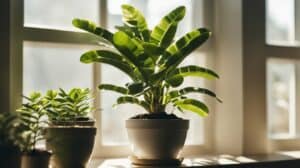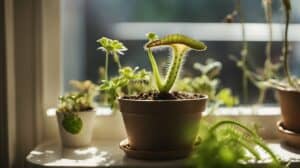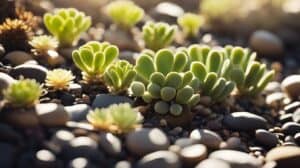Tropical plants are a great way to add a splash of color and vibrancy to any indoor space. One such plant that is gaining popularity for its striking appearance is the Lipstick Plant (Aeschynanthus radicans). With its glossy green leaves and bright red, tubular flowers, it is a stunning addition to any collection of houseplants. However, propagating this plant can be a bit tricky, especially for beginners.

In this article, we will explore the process of propagating Lipstick Plant in detail. We will discuss the different methods of propagation, including stem cuttings and division, and provide step-by-step instructions for each. Additionally, we will cover the ideal growing conditions for this tropical plant, including light, water, and soil requirements. By the end of this article, readers will have all the information they need to successfully propagate and care for their own Lipstick Plant.
Understanding the Lipstick Plant
Species Overview
The Lipstick Plant (Aeschynanthus radicans) is a popular tropical plant that belongs to the Gesneriaceae family. It is native to Southeast Asia, including Malaysia, Indonesia, and Papua New Guinea. The plant is known for its striking red flowers that resemble a tube of lipstick, hence the name. It is a vine that can grow up to 3 feet long and produces clusters of blooms that can last for several months.
The Lipstick Plant has a unique growth pattern, with its stems growing horizontally and then turning upwards. The leaves are dark green and glossy, and they can grow up to 4 inches long. The plant is easy to care for and can thrive in a variety of indoor settings.
Ideal Growing Conditions
The Lipstick Plant thrives in warm, humid environments and requires bright, indirect light. It is best to keep the plant away from direct sunlight, as this can cause the leaves to burn. The plant prefers well-draining soil that is rich in organic matter.
To propagate the Lipstick Plant, it is best to take stem cuttings in the spring or summer. The cuttings should be about 4-6 inches long and should have at least two leaves. Dip the cuttings in rooting hormone and plant them in a pot filled with moist soil. Keep the soil moist and warm, and the cuttings should root within a few weeks.
Overall, the Lipstick Plant is a beautiful and easy-to-care-for tropical plant that can add a touch of color and vibrancy to any indoor space. With the right growing conditions and a little bit of care, the Lipstick Plant can thrive and produce stunning blooms year-round.
Propagation Basics

Preparation Steps
Before propagating a lipstick plant, it is important to gather all the necessary tools and materials. This includes a pair of clean and sharp pruning shears, a container with drainage holes, a well-draining potting mix, and rooting hormone (optional).
The next step is to select a healthy and mature stem from the parent plant that is at least 4-6 inches long. It is best to choose a stem that has a few leaves and nodes since these are the areas where roots will develop. Make sure to cut the stem at a 45-degree angle to increase the surface area for rooting.
Propagation Methods
There are two main methods for propagating lipstick plants:
-
Water Propagation – This method involves placing the stem cutting in a container filled with water and changing the water every few days. Once roots have developed, the cutting can be transferred to a pot with soil.
-
Soil Propagation – This method involves dipping the stem cutting in rooting hormone (optional) and inserting it into a pot with well-draining soil. Keep the soil moist but not overly wet and place the pot in a warm and bright location.
Regardless of the method chosen, it is important to keep the cutting in a warm and humid environment to encourage root growth. This can be achieved by covering the pot with a plastic bag or placing it in a propagator.
With these simple preparation steps and propagation methods, propagating a lipstick plant can be made easy.
Caring for Your New Plant

Post-Propagation Care
Once your lipstick plant has been successfully propagated, it is important to provide it with the proper care to ensure its continued growth and health. Here are some tips for post-propagation care:
- Light: Lipstick plants prefer bright, indirect light. Avoid placing them in direct sunlight as this can scorch their leaves.
- Watering: Water your plant thoroughly when the top inch of soil is dry to the touch. Avoid overwatering as this can lead to root rot.
- Humidity: Lipstick plants thrive in humid environments. You can increase humidity by placing a tray of water near the plant or by using a humidifier.
- Fertilizer: Feed your plant with a balanced fertilizer once a month during the growing season (spring and summer).
Common Challenges
Despite their easy propagation and care, lipstick plants can still face some challenges. Here are some common issues and how to address them:
- Yellowing leaves: This can be a sign of overwatering or too much direct sunlight. Adjust watering and lighting accordingly.
- Wilting leaves: This can be a sign of underwatering or too little humidity. Increase watering and humidity levels.
- Pest infestations: Lipstick plants can attract pests such as spider mites and mealybugs. Treat with a natural insecticide or wipe down leaves with a damp cloth.
By following these tips and addressing any challenges that may arise, you can enjoy your beautiful and vibrant lipstick plant for years to come.
Frequently Asked Questions

What’s the best method to propagate a lipstick plant from a leaf cutting?
The best way to propagate a lipstick plant from a leaf cutting is to take a stem cutting with at least two nodes. Remove the bottom leaves and dip the cut end in rooting hormone. Plant the cutting in a well-draining soil mix and keep it moist, but not soggy. Place the pot in a bright, indirect light and cover it with a plastic bag to create a humid environment. After a few weeks, roots should begin to form, and new growth will appear.
Can I propagate my curly lipstick plant in water, and if so, how?
Yes, you can propagate a curly lipstick plant in water. Take a stem cutting with at least two nodes and remove the bottom leaves. Place the cutting in a jar of water, making sure the nodes are submerged. Change the water every few days to prevent bacterial growth. After a few weeks, roots should begin to form, and new growth will appear. Once the roots are a few inches long, you can transplant the cutting into a well-draining soil mix.
Is it possible to root a black pagoda lipstick plant in water?
Yes, it is possible to root a black pagoda lipstick plant in water. Take a stem cutting with at least two nodes and remove the bottom leaves. Place the cutting in a jar of water, making sure the nodes are submerged. Change the water every few days to prevent bacterial growth. After a few weeks, roots should begin to form, and new growth will appear. Once the roots are a few inches long, you can transplant the cutting into a well-draining soil mix.
What are the steps to separate a mature lipstick plant for propagation?
To separate a mature lipstick plant for propagation, start by gently removing the plant from its pot. Gently tease the roots apart, being careful not to damage them. Look for sections of the plant that have their own root system and can be separated from the main plant. Cut these sections away from the main plant with a clean, sharp knife. Plant each section in a well-draining soil mix and keep it moist, but not soggy. Place the pots in a bright, indirect light and cover them with a plastic bag to create a humid environment.
How do I care for my lipstick plant after propagation to ensure healthy growth?
After propagation, continue to keep the plant in a bright, indirect light and water it when the soil feels dry to the touch. Avoid overwatering, as this can lead to root rot. Fertilize the plant every two to four weeks with a balanced fertilizer during the growing season. Prune the plant regularly to encourage bushy growth and remove any dead or damaged leaves.
What are some popular varieties of lipstick plants that I can propagate at home?
Some popular varieties of lipstick plants that can be propagated at home include Aeschynanthus radicans (lipstick plant), Aeschynanthus pulcher (purple lipstick plant), Aeschynanthus longicaulis (zigzag plant), and Aeschynanthus radicans ‘Mona Lisa’ (Mona Lisa lipstick plant).













